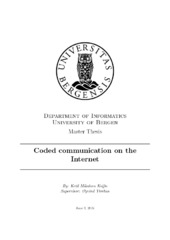Coded communication on the Internet
| dc.contributor.author | Kvifte, Ketil Mikalsen | |
| dc.date.accessioned | 2019-06-26T00:31:59Z | |
| dc.date.available | 2019-06-26T00:31:59Z | |
| dc.date.issued | 2019-06-26 | |
| dc.date.submitted | 2019-06-25T22:00:10Z | |
| dc.identifier.uri | https://hdl.handle.net/1956/20416 | |
| dc.description.abstract | The Internet is giving people many opportunities to interact, but for latency-sensitive activities, there is still room for improvement. It is not always good enough that messages arrive; some times they should arrive quickly. The User Diagram Protocol does not give any guarantees that the messages will arrive, and the Transmission Control Protocol only guarantees that it will arrive, not how fast it will arrive. In this thesis, we explore how the combination of convolutional codes and Automatic Repeat-reQuests can help reduce the latency in our communications, and how memory maximum distance separable codes give better results than comparable random codes. | en_US |
| dc.language.iso | eng | |
| dc.publisher | The University of Bergen | en_US |
| dc.subject | latency | |
| dc.subject | convolutional codes | |
| dc.subject | coding theory | |
| dc.title | Coded communication on the Internet | |
| dc.type | Master thesis | |
| dc.date.updated | 2019-06-25T22:00:10Z | |
| dc.rights.holder | Copyright the Author. All rights reserved | en_US |
| dc.description.degree | Masteroppgåve i informatikk | en_US |
| dc.description.localcode | INF399 | |
| dc.description.localcode | MAMN-INF | |
| dc.description.localcode | MAMN-PROG | |
| dc.subject.nus | 754199 | |
| fs.subjectcode | INF399 | |
| fs.unitcode | 12-12-0 |
Files in this item
This item appears in the following Collection(s)
-
Master theses [197]
